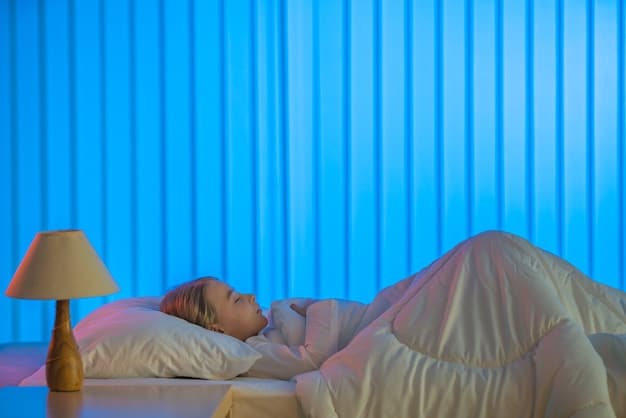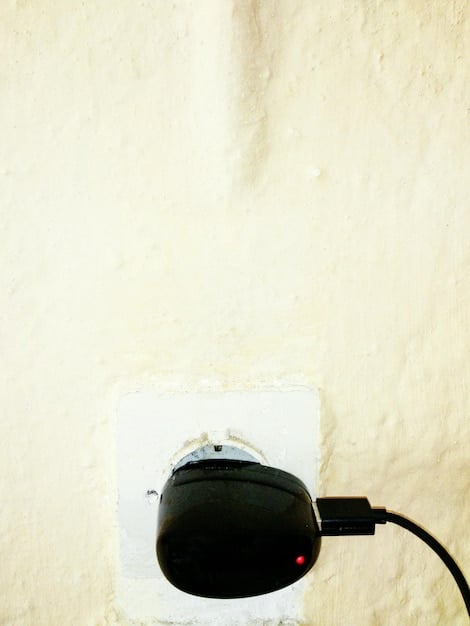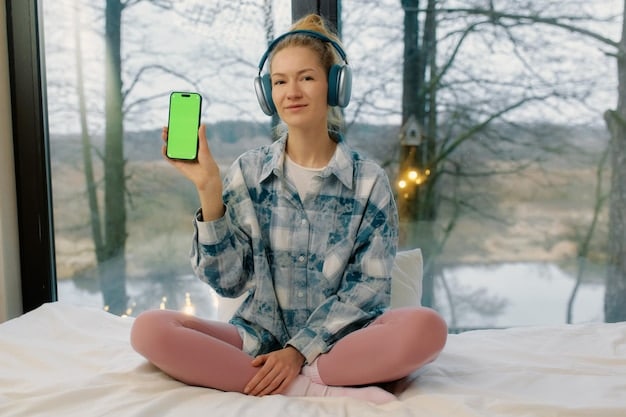Save Money and Sleep Soundly: Ditching Your Sound Machine

The financial impact of ditching the sound machine can save you up to $300 a year by reducing energy consumption and battery costs, offering a more sustainable and economical sleep solution.
Are you looking for ways to save money without sacrificing a good night’s sleep? The financial impact of ditching the sound machine might be more significant than you think.
The Hidden Costs of Sound Machines
Sound machines are often marketed as essential sleep aids, but have you ever considered the long-term costs? Beyond the initial purchase price, these devices can quietly drain your wallet.
Let’s delve into the expenses associated with continuous use.
Energy Consumption
Many sound machines need to be plugged in and run for extended periods to be effective. Although individual devices may consume a small amount of electricity, the cumulative effect over a year can add up to noticeable costs.
Battery Replacements
Some portable sound machines require frequent battery replacements. The ongoing expenses for batteries can be surprisingly high, especially if using disposable batteries instead of rechargeable alternatives.

Did you know that these hidden costs may include:
- Increased electricity bills due to constant use.
- The expense of replacing batteries multiple times a year.
- Potential damage to the device requiring replacement when batteries leak.
The financial impact is both direct and indirect, potentially affecting your budget more than you would expect.
Estimating Your Sound Machine’s Yearly Expenses
To understand the financial impact of ditching the sound machine, it’s important to estimate how much your device is costing you each year. Here’s how to do the math.
First, assess energy use of your sound machine.
Calculating Energy Costs
Find the wattage of your sound machine (usually printed on the device) and multiply by the number of hours it’s used daily. Multiply that by 365 for the yearly consumption in watt-hours.
Estimating Battery Costs
If using batteries, determine how often you need to replace them. Multiply the cost of each set of batteries by the number of replacements per year.
To assist with this, consider the following:
- Document the electricity bills prior to using the sound machine
- Calculate the number of battery sets used within a month.
- Factor in the cost of any replacement parts.
By reviewing your own data, you can better understand the comprehensive costs associated with your sound machine.
Effective and Economical Alternatives
Switching from a sound machine doesn’t mean sacrificing quality sleep. Several alternatives can be just as effective and easier on your wallet.
These alternatives offer similar benefits without the ongoing costs.
Ambient Noise Apps
Smartphone apps that produce ambient noise are a cost-effective alternative. Many come with free options, and premium versions often have lower subscription fees.
Nature Sounds
Utilizing recordings of nature sounds like rain, ocean waves, or forest atmospheres can create a soothing environment. These recordings are often available for free on streaming services or as digital downloads.

Consider:
- Free streaming options that provide extensive libraries of ambient sounds.
- Using household items, like a fan, to generate background noise.
- Investing in a high-quality pillow or mattress.
These alternatives offer a great deal of flexibility and may fit better within your lifestyle and budget.
The Environmental Impact of Sound Machines
Apart from financial considerations, sound machines also have environmental implications. The manufacturing, usage, and disposal of these devices contribute to ecological concerns.
Understanding these implications can help you make more eco-friendly choices.
E-Waste
Electronic waste is a growing global problem. When sound machines break or become obsolete, they often end up in landfills, releasing pollutants into the environment.
Resource Consumption
The production of sound machines requires significant resources, from the extraction of raw materials to the energy used in manufacturing. Reducing your usage can decrease demand and conserve resources.
Key environmental impacts:
- Pollution caused by battery acid leakage in landfills.
- High levels of carbon emissions due to the manufacturing process.
- Depletion of resources for creating new devices.
Making mindful choices can reduce your carbon footprint.
Tips for Transitioning Away from Your Sound Machine
If you’re ready to make the switch, here are some practical tips to smoothly transition away from using a sound machine. Gradual changes can make the shift easier and more comfortable.
These guidelines offer a balanced approach to ensure you maintain good sleep habits.
Gradually Reduce Volume
Over several nights, gradually lower the volume of your sound machine. This allows your brain to adapt to quieter surroundings without a sudden change.
Introduce New Sounds
Start playing ambient sounds from an app or streaming service at a low volume. Slowly replace the sound machine’s noise with these new, more natural sounds.
Simple methods for a smooth transition:
- Use blackout curtains to block out external light.
- Try relaxation techniques before bed, such as deep breathing or meditation.
- Ensuring a consistent sleep schedule to regulate your body’s natural sleep-wake cycle.
Adjust your strategy based on individual comfort and needs for an easy transition.
Long-Term Benefits of Natural Sleep Environments
Embracing natural sleep environments can yield long-term benefits beyond just financial savings. These environments often foster better physical and mental health.
A natural sleep setting promotes overall well-being.
Improved Sleep Quality
Natural sound environments can improve sleep quality by reducing reliance on artificial stimuli. The absence of electronic devices in the bedroom can also help reduce mental stimulation before bed.
Enhanced Mental Health
Natural sounds and quieter environments support mental health by reducing stress and promoting relaxation. A peaceful bedroom setting can contribute to a more positive mood and overall sense of well-being.
Explore:
- The correlation between a calm environment and reduced stress levels.
- Benefits of a dark sleep environment
- How sleep affects metabolism and bodily functions.
Moving towards a natural sleep environment is beneficial for your overall health.
| Key Aspect | Brief Description |
|---|---|
| 💡 Energy Costs | Sound machines consume energy daily, leading to increased electricity bills over time. |
| 🔋 Battery Expenses | Portable sound machines need regular battery replacements, adding to yearly costs. |
| 📱 Ambient Noise Apps | Use smartphone apps with free or low-cost options for ambient sounds. |
| 🌿 Natural Sounds | Opt for nature sounds like rain or ocean waves available on streaming services or household objects to generate background noise. |
[Frequently Asked Questions]
What are the main financial drawbacks of using a sound machine?
▼
The primary financial drawbacks include increased energy consumption leading to higher electricity bills, the ongoing cost of replacing batteries for portable machines, and potential repair costs.
▼
By ditching a sound machine, you can potentially save up to $300 annually, factoring in energy consumption and/or battery replacement costs, depending on your usage.
▼
Yes, several free alternatives exist, such as ambient noise apps with free options, nature sounds available on streaming services, and natural household sounds like a fan.
▼
Sound machines contribute to e-waste when discarded, consume resources during manufacturing, and may lead to battery acid pollution in landfills, affecting the environment.
▼
To transition, gradually reduce the sound machine’s volume, introduce new sounds using apps or streaming services, and control external factors using blackout curtains or relaxation techniques for a smooth shift.
Conclusion
Ultimately, assessing the financial impact of ditching the sound machine can lead to significant savings and healthier sleep. By exploring alternatives and understanding the hidden costs, you can foster a more economical and environmentally friendly sleep routine.
Read more content





